雅思语法复习状语从句
- 格式:ppt
- 大小:5.84 MB
- 文档页数:22
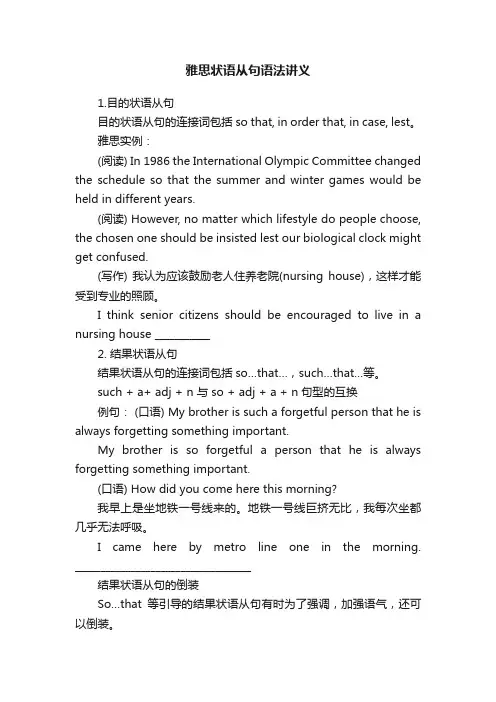
雅思状语从句语法讲义1.目的状语从句目的状语从句的连接词包括so that, in order that, in case, lest。
雅思实例:(阅读) In 1986 the International Olympic Committee changed the schedule so that the summer and winter games would be held in different years.(阅读) However, no matter which lifestyle do people choose, the chosen one should be insisted lest our biological clock might get confused.(写作) 我认为应该鼓励老人住养老院(nursing house),这样才能受到专业的照顾。
I think senior citizens should be encouraged to live in a nursing house ___________2. 结果状语从句结果状语从句的连接词包括so…that…,such…that…等。
such + a+ adj + n 与 so + adj + a + n句型的互换例句: (口语) My brother is such a forgetful person that he is always forgetting something important.My brother is so forgetful a person that he is always forgetting something important.(口语) How did you come here this morning?我早上是坐地铁一号线来的。
地铁一号线巨挤无比,我每次坐都几乎无法呼吸。




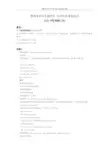
雅思基础写作第四讲动词与非谓语动词动词概况定义:表示动作或状态的词叫做动词。
可分为四类,分别是:实义动词、系动词、助动词、情态动词。
有些情况下,有些动词是兼类词:We are having a meeting.He has gone to New York.分类:1.实义动词--- play, eat, murder, investigate2.系动词本身有词义,系动词后面必须接表语,用来说明主语的状况、性质、特征等。
be;seem, look, appear;remain, keep, stay;feel, smell, sound, look;become, turn, grow, fall;prove, turn out翻译:这谣言证明有假。
他开会时总是保持沉默。
他看起来很生气。
这花闻起来很香。
他梦想成为一名保安。
3.助动词---be, have, do, shall, will, should, would协助主要动词构成谓语动词的词叫助动词。
助动词自身没有词义,不可单独使用:He doesn't like English.助动词协助主要动词完成以下功用,可以用来:a. He is singing.He has got married.b. He was sent to England.c. Did you study English before you came here?d. I don't like him.e. Do come to the party tomorrow evening.He did know that.4.情态动词---must, need, can, may, should, dare , ought to, have to情态动词用法?Exercise: find all the verbs that are contained in the following passage.A good chess playerA man went to visit a friend and was amazed to find him playing chess with his dog. He watched the game in astonishment for a while. "I can hardly believe my eyes!" he exclaimed. "That's the smartest dog I've ever seen.""Nah, he's not so smart," the friend replied. "I've beaten him three games out of five."非謂語動词:讓句子簡潔有力定义:在句子中充当除谓语以外的句子成分的动词形式叫做非谓语动词。
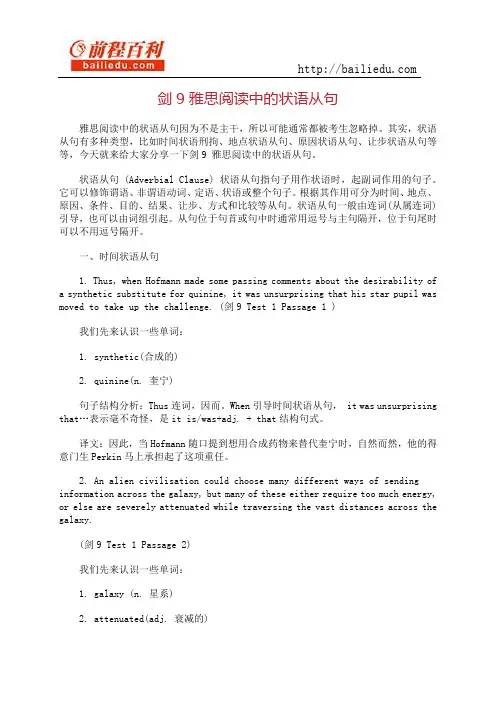
雅思阅读中的状语从句因为不是主干,所以可能通常都被考生忽略掉。
其实,状语从句有多种类型,比如时间状语刑拘、地点状语从句、原因状语从句、让步状语从句等等,今天就来给大家分享一下剑9 雅思阅读中的状语从句。
状语从句 (Adverbial Clause) 状语从句指句子用作状语时,起副词作用的句子。
它可以修饰谓语、非谓语动词、定语、状语或整个句子。
根据其作用可分为时间、地点、原因、条件、目的、结果、让步、方式和比较等从句。
状语从句一般由连词(从属连词)引导,也可以由词组引起。
从句位于句首或句中时通常用逗号与主句隔开,位于句尾时可以不用逗号隔开。
一、时间状语从句1. Thus, when Hofmann made some passing comments about the desirability ofa synthetic substitute for quinine, it was unsurprising that his star pupil was moved to take up the challenge. (剑9 Test 1 Passage 1 )我们先来认识一些单词:1. synthetic(合成的)2. quinine(n. 奎宁)句子结构分析:Thus连词,因而。
When引导时间状语从句, it was unsurprising that…表示毫不奇怪,是it is/was+adj. + that结构句式。
译文:因此,当Hofmann随口提到想用合成药物来替代奎宁时,自然而然,他的得意门生Perkin马上承担起了这项重任。
2. An alien civilisation could choose many different ways of sending information across the galaxy, but many of these either require too much energy, or else are severely attenuated while traversing the vast distances across the galaxy.(剑9 Test 1 Passage 2)我们先来认识一些单词:1. galaxy (n. 星系)2. attenuated(adj. 衰减的)句子结构分析:这句话的主干是An alien civilisation could choose…but many of these either require too much en ergy, or …while…,这句话里包含either…or…句式,表示或者……或者……,while引导时间状语从句。


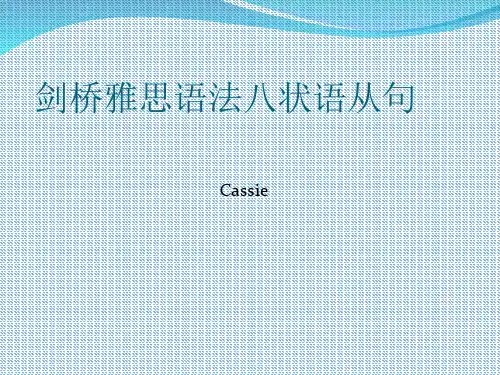
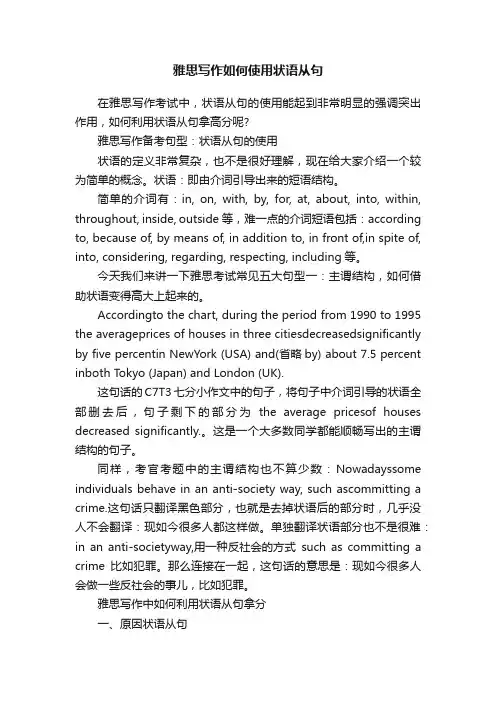
雅思写作如何使用状语从句在雅思写作考试中,状语从句的使用能起到非常明显的强调突出作用,如何利用状语从句拿高分呢?雅思写作备考句型:状语从句的使用状语的定义非常复杂,也不是很好理解,现在给大家介绍一个较为简单的概念。
状语:即由介词引导出来的短语结构。
简单的介词有:in, on, with, by, for, at, about, into, within, throughout, inside, outside等,难一点的介词短语包括:according to, because of, by means of, in addition to, in front of,in spite of, into, considering, regarding, respecting, including等。
今天我们来讲一下雅思考试常见五大句型一:主谓结构,如何借助状语变得高大上起来的。
Accordingto the chart, during the period from 1990 to 1995 the averageprices of houses in three citiesdecreasedsignificantly by five percentin NewYork (USA) and(省略by) about 7.5 percent inboth Tokyo (Japan) and London (UK).这句话的C7T3七分小作文中的句子,将句子中介词引导的状语全部删去后,句子剩下的部分为the average pricesof houses decreased significantly.。
这是一个大多数同学都能顺畅写出的主谓结构的句子。
同样,考官考题中的主谓结构也不算少数:Nowadayssome individuals behave in an anti-society way, such ascommitting a crime.这句话只翻译黑色部分,也就是去掉状语后的部分时,几乎没人不会翻译:现如今很多人都这样做。
雅思基本功训练之状语从句的简化Part I:单词与短语a clear conscience 一个透明的良知(问心无愧);butcher n.屠户;wallet n.钱包;savings n.积蓄;villager n.村里人;be wrapped up in newspaper包在报纸里;contain vt.装着,盛着;pay back(动词短语)归还(钱)Part II:语法学习1.状语从句的简化我们学过了定语从句的简化过程,这里再系统学习状语从句的简化规则。
请记住:当状语从句的主语与主句的主语一致时便可以进行简化。
简化时,把状语从句的动词根据主动与被动需要处理成从属性的ing形式或过去分词形式即可。
示例1:Sam lost his wallet while he was taking his savings to the post office.Sam lost his wallet while taking his savings to the post office.或:While taking his savings to the post office, Sam had lost his wallet.示例2:When the city is seen from the top of the hill, it looks very small.Seen from the top of the hill, the city looks very small.示例3:Since I have finished my work for today, I will go out for a long walk.Having finished my work for today, I will go out for a long walk.2.定语从句的继续示例:It contained half the money (which) he had lost.(which作宾语,可以省略)Part III:综合训练The whole village soon learnt (1) a large sum of money (2) been lost. Sam, the local butcher, lost his wallet (3) (4 take) his savings to the post office. Sam was sure (5) the wallet must (6) been (7 find) by one of the villagers, (8) it was not (9 return) to him. Three months passed (10) then one morning, Sam (11 find) his wallet (12) his front door. It (13) been (14 wrap) (15) in newspaper (16) it contained half the money he (17) lost, together (18) a note (19) said: “A thief? Yes, (20) only 50% a thief!”Two months later, some more money was sent (21) Sam (22) another note: “Only 25% a thief now!”(23) time, all Sam’s money was (24 pay) back (25) this way. The last note (26 say): “I am 100% honest now!”答案:(1) that; (2) had; (3) while; (4) taking; (5) that; (6) have;(7) found; (8) but; (9) returned; (10) and; (11) found; (12) outside; (13) had; (14) wrapped; (15) up; (16) and; (17) had; (18) with; (19) which; (20) but; (21) to; (22) with; (23) In; (24) paid;(25) in; (26) saidPart IV:句子翻译1. 全村很快就知道了一大笔钱被弄丢了。